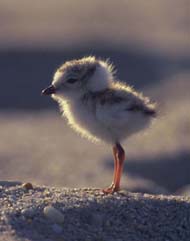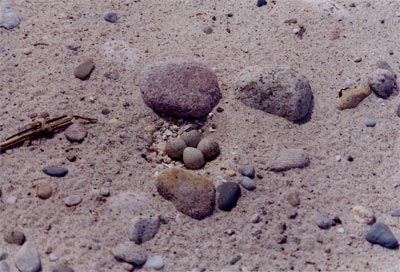Almanac/Piping Plovers
Air Date: Week of June 6, 2003
This week, we have facts about piping plovers. This time of year these shore-dwelling birds are welcoming the next generation.
Transcript
CURWOOD: Welcome back to Living on Earth. I’m Steve Curwood.
[BEACH SOUNDS] & [MUSIC: Michael Hedges “Ragamuffin” Aerial Boundaries - Windam Hill (1984)]
 A newborn piping plover chick (Photo: ©Richard Kuzminski) A newborn piping plover chick (Photo: ©Richard Kuzminski) |
CURWOOD: Ah yes. You’re on a beach inhaling salty air and warming yourself in the spring sun. You hear peeping, but don’t see anything.
[PEEPING SOUND] CURWOOD: Suddenly, a six-inch patch of sand darts forward, and just as suddenly, it stops. If your eyes are quick you’ll spot a piping plover. These shore birds are busy chasing after their young this time of year. Piping plovers breed on the Northern Atlantic seashores and beaches of prairie lakes. In a nest that’s no more than a depression in the sand, really, the female lays two to four eggs. Throughout a month of incubation, the parents do a changing of the guard to give each other breaks. When the eggs finally crack, little puffballs on sticks emerge. Piping plover chicks can take care of themselves almost immediately. They’re up and running within a few hours of the hatch. Throughout their lives, camouflaging helps piping plovers blend into the sand. But because they are hard to see, the birds and their eggs are easily crushed. This, paired with habitat loss, put piping plovers on the endangered species list in 1986. Protection under the law gives this little bird a lot of clout. One nesting pair caused the relocation of Nantucket Island’s July Fourth fireworks last year.  (Photo: John Maclaine ©2002)
Links
|





